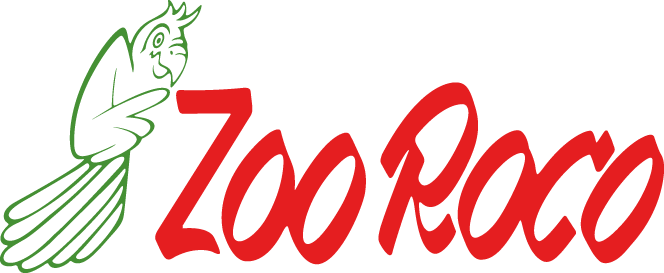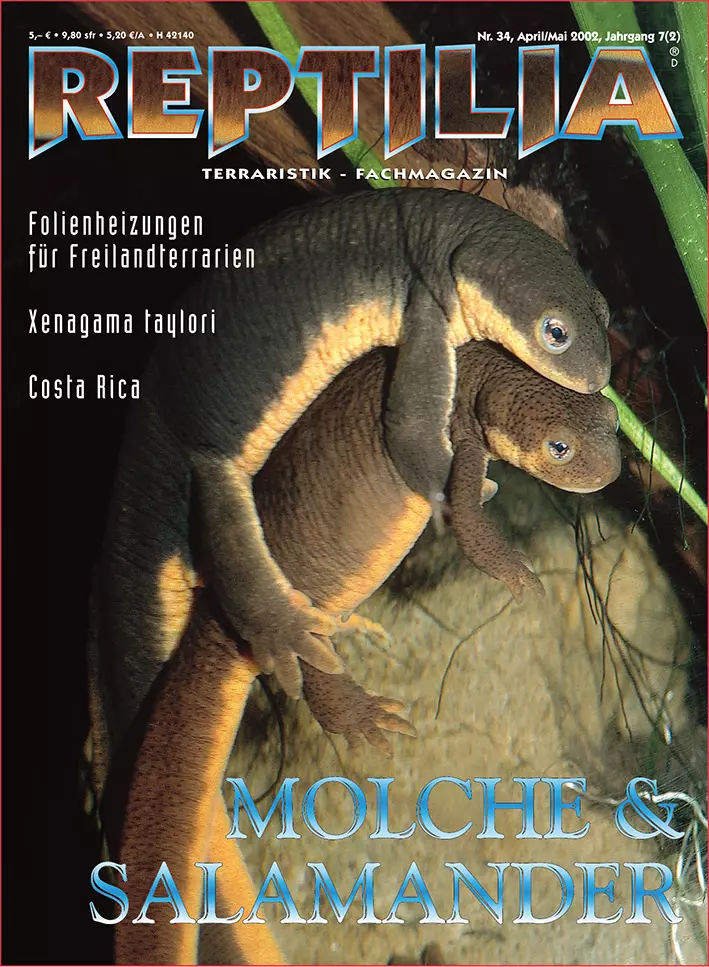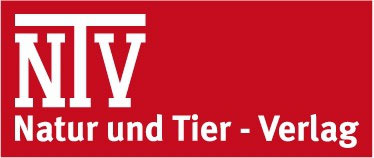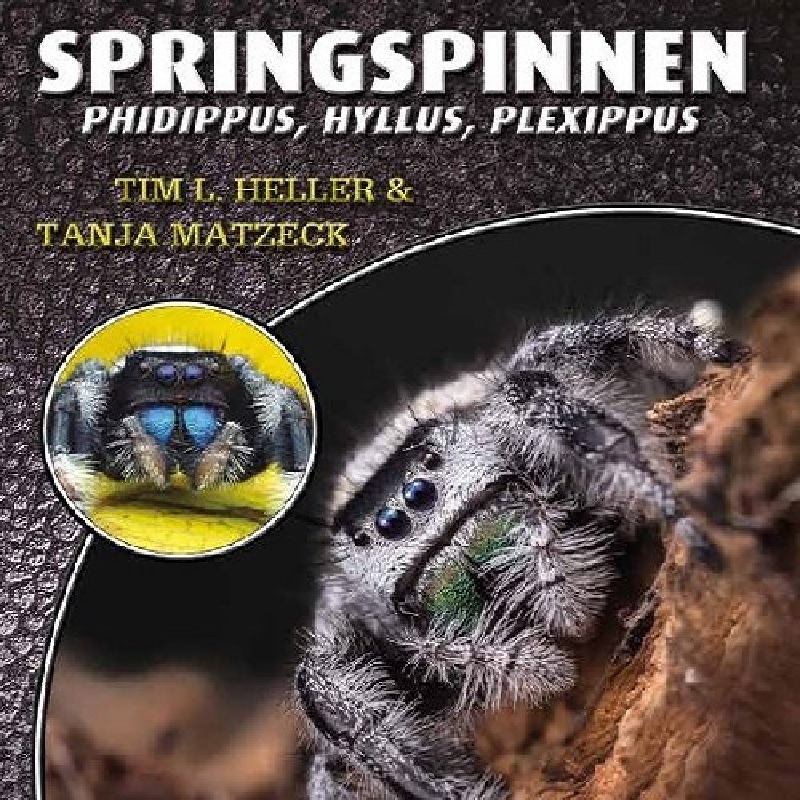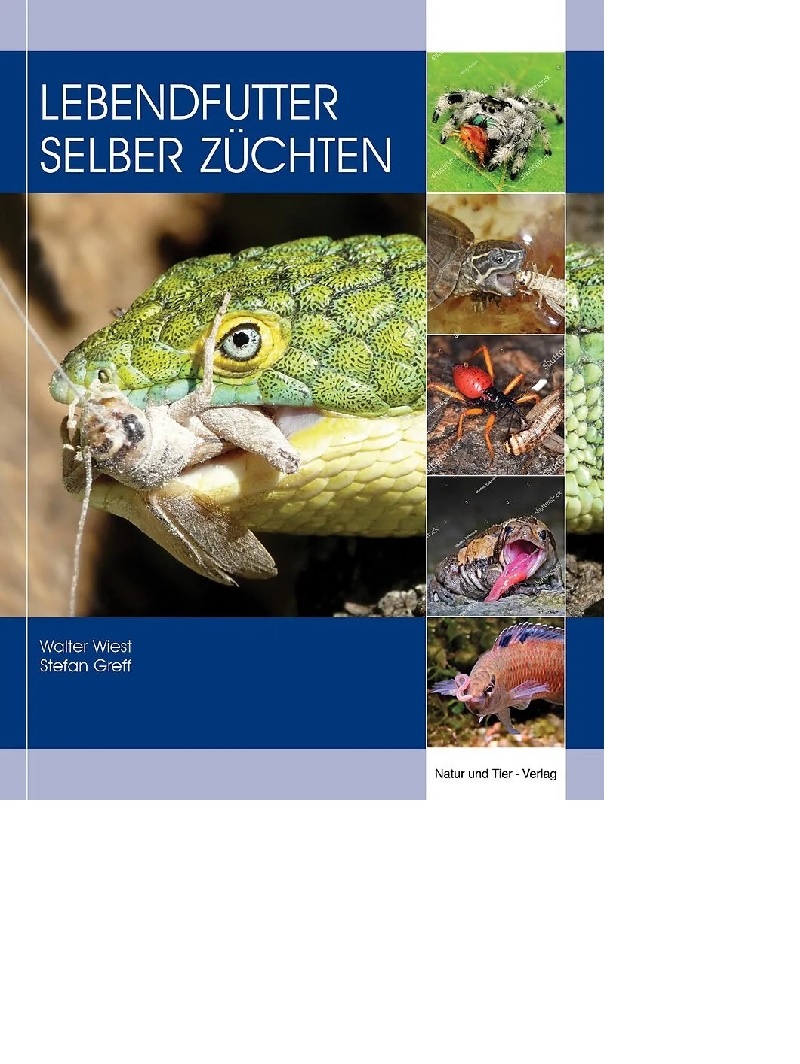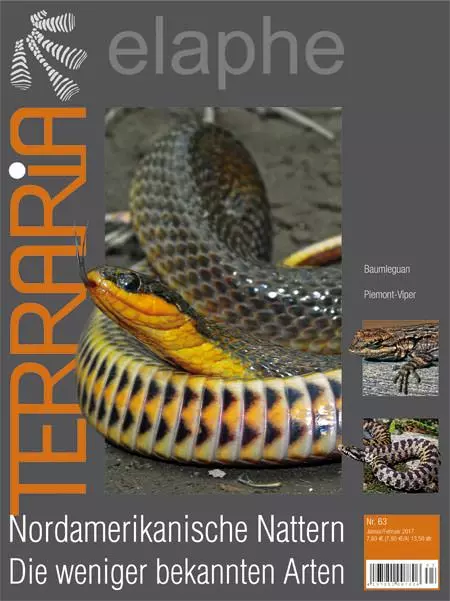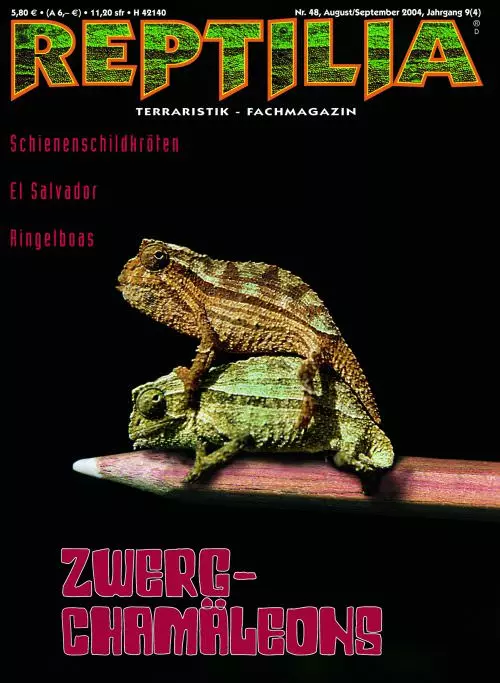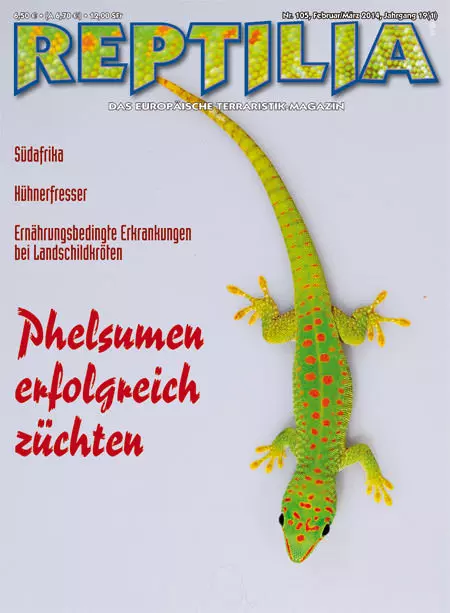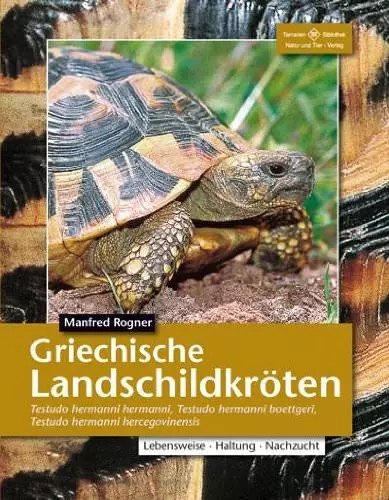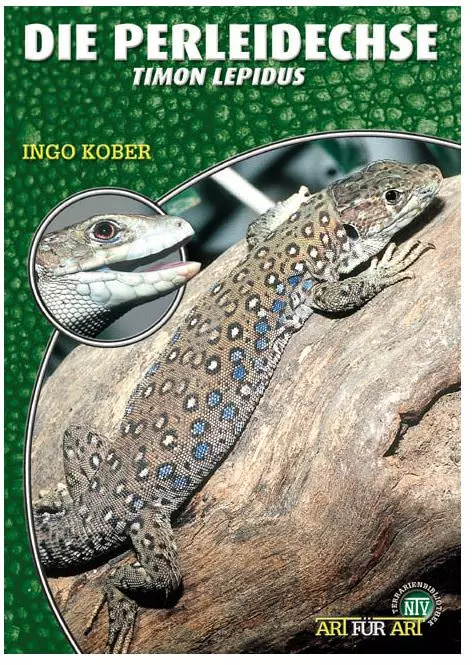Reptilia 34 Efts & Salamanders
Foil heaters for outdoor terrariums
Xenagama taylori
In the roof of the rainforest
Content:
2 EDITORIAL
4 READER'S LETTERS
6 MAGAZINE
16 DATES
20 WESTERN HERP PERSPECTIVES
September - Ambush Attack
from B. Love
22 PHOTO REPORTAGE
caudates
by M. Staniszewski
30 HUSBANDRY AND BREEDING
The band newt Triturus vittatus ophryticus
by Uwe Dost
35 REPORT
Unequal Brothers - The European Mountain Creek Newt (Genus Euproctus)
by B. Thiesmeier & C. Hornberg
43 TRAVEL
In search of beavertail agams (Xenagama - A journey to Somaliland
by A. Roos
51 PORTRAIT AND POSTER
Agalychnis callidryas
by M. Schmidt
56 HUSBANDRY AND BREEDING
The Indian star turtle Geochelone elegans (Schoepff, 1795) - a problematic tropical land turtle? - Part 3: Offspring
by H.-J. Bidmon
63 REPORT
Life above our heads: Amphibians and reptiles in the treetops of the Central American rainforest
by T. Leenders
70 HUSBANDRY AND BREEDING
Biology, Care and Breeding of Snakes of the Genus Pseustes (Fitzinger, 1834)
by A. Hohmeister & F. Fiegenbaum
75 REPORT
"The foil heating - a simple and inexpensive possibility for the heat addition in free systems
by U. Strathemann
78 REPORT
The oven fish (Thermobia domestica) - an ideal addition to the menu for numerous terrarium birds
by W. Schmidt
81 REPTILIA ON THE ROAD
Innsbruck Alpine Zoo
by M. Hallmen
88 CLASSIFIEDS
92 ADVICE AND ACTION
94 LIBRARY
104 GLOSSE
Recently at the WG-Party
by Heiko Werning
And here is an overview of the contents:
This time your terraristics magazine is titled Molche & Salamander!
It goes without saying that there should be a beautifully illustrated photo story in which an excerpt from the great variety of shapes of the tail amphibians is presented to you. And of course you will also get an overview of the essential facts about this amphibian order, its systematics, habitat, development and much more!
The band newt Triturus vittatus ophryticus
In the wedding robe, the males of this subspecies of the band newt from Turkey and the Caucasus are certainly among the most spectacular amphibians of all: Apart from the magnificent coloration, the high and serrated ridge of the back makes the animals, which can reach a length of almost 20 cm in extreme cases, look like bizarre little dragons! Uwe Dost describes in detail and practically how to keep and breed these jewels among the newts, how to set up a suitable tank, how to care for the animals, and how to avoid possible problems from the beginning. In principle, however, the keeping and reproduction of the "water dragons" are not too difficult, so that after reading this article every amphibian friend will surely wish to take care of the beautiful newts himself!
Unequal Brothers - The European Mountain Creek Newt (Genus Euproctus)
For a long time, little was known about the three species of the genus Euproctus in every respect, and they were regarded as not or only very difficult to keep and breed. Burkhard Thiesmeier and Claudia Hornberg describe here as examples, how a deepened knowledge of the habitat and the living conditions of a species has a positive effect on the care results. What do the biotopes of the respective species actually look like, and what consequences does this have for husbandry? Do the animals need an aquarium or a terrarium? These and all other relevant questions for a successful breeding of the rarely maintained mountain stream newts are answered by the authors in detail and competently. Try these highly interesting newts with their unique mating behaviour!
Life above our heads: Amphibians and reptiles in the treetops of the Central American rainforest
It is well known that the deep sea is still a largely unexplored "continent". However, it is far less known that the canopy of the tropical rainforest contains an unbelievable wealth of species, only a fraction of which has so far been recorded. Twan Leenders himself has been researching the "treetop" habitat for a long time and now offers you an insight into this fascinating foreign world: the bizarre Bolitoglossa salamanders with their oversized feet, flying frogs, giant anole, bromeliad lizards, they all have amazing adaptations to their biotope high above the ground. How, for example, do the amphibians that are normally bound to water reproduce up there, how do they find partners in this extensive habitat? And what is a snake known as a digging species looking for at lofty altitudes? An extraordinary contribution with extraordinary insights!
"The foil heating" - a simple and inexpensive possibility for the heat supplement for free plants
Anyone who cares for reptiles in the field knows the problem: In our latitudes it is difficult to ensure sufficient heat supply. If the weather is too cool and humid, the animals become ill quite quickly. One creates remedy with expensive and current eating radiators - or with the cleveren foil heating , whose production and effectiveness Udo Strathemann describes to you. This article will show you two different ways to help you offer your reptiles adequate conditions outside, which will of course also have a positive effect on their vitality and probably their reproductive success!
The Indian star turtle Geochelone elegans (Schoepff, 1795), a problematic tropical tortoise? Several years of keeping and reproduction in Germany
So here is the third part of this incredibly detailed and highly descriptive report by Hans-J. Bidmon. This time the author dedicates himself to the successful breeding of his animals, describes mating behaviour, egg laying and incubation. Exact details and data - especially for the solution of problem cases - make this contribution interesting not only for all keepers of the beautifully drawn Indian star tortoise, but each tortoise friend can deduce from it conclusions, which surely benefit his own animals!
The oven fish (Thermobia domestica): An ideal enrichment of the menu for numerous terrarium birds. If you feed your insect-eating terrarium birds day in, day out with crickets or crickets, you are certainly doing something wrong. Here Wolfgang Schmidt presents a possible alternative with the oven fish, a relative of the well-known silver fish. This urine insect offers many obvious advantages for breeding as a food animal: For example, it can be easily kept and reproduced, does not make any special demands on the food, and escaped specimens normally cannot reproduce in the home and therefore do not become a plague. Particularly important: not immediately eaten Ofenfischchen nibble neither the planting nor the terrarium animals themselves! Wolfgang Schmidt gives all important tips for the breeding, from the equipment of the containers over the attitude conditions up to the efficient feeding. The oven fish - a change in the menu that you should treat your amphibians or lizards to!
In search of beavertail agamas (Xenagama) - A journey to Somaliland
Do you know anything about beaver tail agams? Have you ever been to Somaliland? If you answered both questions with "no", you certainly do not belong to the minority! There was hardly anything known about the genus Xenagama until now, and Somaliland is not exactly the main destination of sun-hungry African tourists. Alexander Roos, who carried out field biological studies on these very special animals there, describes the difficulties one has to struggle with when travelling to this region. The author's enthusiasm for the soon to be very trustful little agamas in the terrarium will certainly be passed on to the REPTILIA readers, especially as it is difficult to escape the impression of the beautiful photos of the cute guys anyway!
Biology, care and breeding of snakes of the genus Pseustes (Fitzinger, 1843)
And also with this article by Andreas Hohmeister and Franz Fiegenbaum we can offer you information about reptiles, of which so far practically no data from the terrarium keeping was available! The attractive, tree-dwelling species of the genus Pseustes are unfortunately still very rare guests in Central European terrariums, but the authors were able to cultivate two species successfully and even bring one of them several times to offspring. This probably fails with the other species only because of the lack of a female, because Hohmeister and Fliegenbaum describe the large, powerful vipers as very suitable fosterlings.
A real treat for all snake fans!
In addition to the above-mentioned articles, you will of course also find in this REPTILIA all the services you are accustomed to from your trade magazine, such as the sections Advice & Action, Dates, Posters, Classifieds, Library and of course the popular incubator not to forget!
Login
